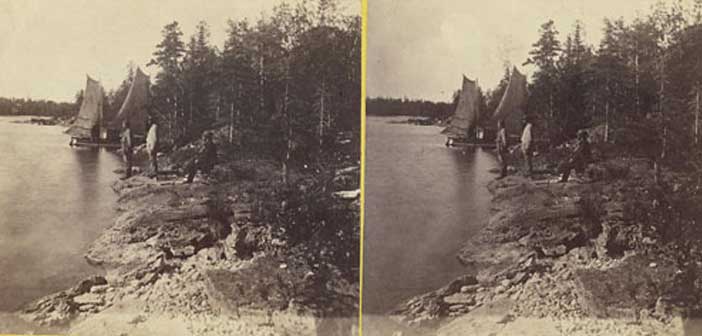Part V: Surveying Manitoulin’s Tehkummah, Allan, Campbell and Carnarvon Townships
EDITOR’S NOTE: This week Shelley Pearen continues her series on the 19th century Manitoulin surveys. The January 15 and 22, April 2, and July 9 2014 editions of The Expositor carried her accounts of Manitoulin’s initial survey, the Anishinaabe reaction to the surveyors and the surveyor’s descriptions of Assiginack, Bidwell, Billings, Howland and Sheguiandah Townships.
by Shelley Pearen
The surveying of Manitoulin proceeded despite the ongoing protests by the Anishinaabe residents against the 1862 treaty. Five townships were surveyed by the end of 1864. Concurrently the Anishinaabeg carried out a campaign to have the treaty cancelled. They petitioned the governor repeatedly and successfully captured the attention of the nation’s journalists and members of Parliament.
In March 1864 the Anishinaabeg issued a statement for the press: “We, Indians of the Ottawa and Chippewa Tribes, sole proprietors of the Great Manitoulin Island, do wish to inform all the colonists and speculators desirous of securing lands in the aforesaid Island, that we never ceded to the Government, our rights to any portion thereof and consequently the Crown Land Department can neither cause the said Great Manitoulin to be surveyed, nor put up for sale, or alienate any portion of the aforesaid Island, which we possess in common.” The following year, in July 1865, a grand council was held in Wikwemikong where a petition was written to the governor demanding the cancellation of the treaty and signed by 17 of the 18 treaty signatories.
Nevertheless the surveying continued as did local superintendent Charles Dupont’s attempt to assign the Anishinaabe residents to specific lots. Tehkummah township was surveyed in 1866. Allan and Campbell in 1867, and Carnarvon was partially surveyed in 1867.
Tehkummah
George Brockett Abrey surveyed a large portion of Tehkummah township in 1866. “The whole south shore of the township, bordering on Lake Huron, extending inland a distance of a couple of miles, is a smooth limestone rock, supporting a growth of small cedars growing very closely together, with some spruces, balsams, birches and balm of Gilead intermixed.” He described the soil as sandy in the hardwood ridges and clayey loam in the swampy areas.
Abrey recommended South Bay for a town plot. It had an excellent harbor and was “one of the best fishing stations on the island.” South Bay was a traditional Anishinaabe fishing settlement but most of the original inhabitants had already been persuaded to relocate according to the terms of the 1862 treaty. Apparently by 1866 only “a few Indians, remain at the point, at the entrance to South Bay, during the fishing season.”
Michael’s Bay was the site of an ancient Native settlement. Within months of the survey it was transformed into a timbering and sawmill settlement. By the fall of 1867 it was home to about 20 sawmill workers. Abrey described “Michall’s Bay” as a good place for fishing but lacking security as a harbor for large vessels.
He was not overly impressed: “At present the township offers very little inducements to the settler, the south side being barren, the township of Sandfield on the north unsurveyed, and Assiginack not opened up, renders this township quite isolated. Tehkummah must be settled from towards the north, as in that direction will be the markets, and in that direction lies most of the best of the land.” He recommended constructing a road between South Bay and Manitowaning to encourage settlement.
Like most of his colleagues Abrey was skeptical about Manitoulin’s land, but unlike his colleagues he actually settled on Manitoulin where he continued to work as a surveyor for many years. In 1867 alone he surveyed Tehkummah, Campbell and Carnarvon townships.
Allan Township
Francis Bolger surveyed Allan Township in 1867. “The portion of the township best adapted for agricultural purposes lies to the south of the line between the 8th and 9th concessions.” “I did not deem it necessary to sub-divide, acting according to your instructions, that no lands unfit for settlement were to be surveyed.”
“The greatest variety and the best quality of timber, as also the richest agricultural lands, are invariably to be found around Kagawong and Ice Lakes.” A belt of excellent hardwood that was used by the Indians as a sugar-bush was noted in the central part of the township.
Kagawong Lake “abounds in whitefish, bass, herring, and other varieties of fish, affording the Indians living on its shores an inexhaustible supply of food.” The Kagawong River’s potential was noted.
Ice Lake was described as very shallow, with some fish, and some excellent and timbered land bordering its eastern and western shores.
The Indian village of Kagawong was reduced to four houses by 1867 because many residents had already been relocated according to the terms of the 1862 treaty. Bolger did not have high hopes for Kagawong village because of the shallow water and exposed position of Mudge Bay.
Campbell
George Brockett Abrey surveyed Campbell Township in 1867. “I have to regret that very little land suitable for settlement was found in any portion.” He described the land as quite level with rock lying within a very few inches of the surface covered with a few inches of vegetable deposit. “In some places a few inches of light sand intervenes between the rock and the surface deposit.”
Abrey explained that “it is possible that some small patches of good land may exist which were unobserved at the survey in consequence of the considerable depth of snow which concealed the ground at the time, but they cannot be sufficient extent to be worthy of search or the attention of the agriculturalist.” He described the township as covered in cedar, balsam, spruce, birch, and balm of Gilead, except for some spots of maple hardwood.
Carnarvon
George Brockett Abrey surveyed part of Carnarvon Township in 1867. Edgar Bray completed the survey in 1870. Abrey’s report was not favourable. “Excepting a narrow strip of land on each side of the Portage Road” between Mindemoya Lake and Providence Bay and a strip extending into the Township of Campbell, and others just east and west of Lake Mindemoya “no land exists within the survey fit for agricultural purposes.” “The soil in these sections is a light sandy loam, pretty free from stone and timbered mostly with hardwood chiefly maple. The remainder of the township, except where swamps occur and around Providence Bay, is a smooth limestone rock covered with a few inches of sand.”
Abrey found a large cedar swamp south of Lake Mindemoya and several smaller swamps. At Providence Bay the “tract of red and white pine of inferior quality stretches a belt of about a mile in width” but “its quality and quantity would not, in my, opinion, warrant its being advisable to set it apart for lumbering purposes.”
“The advantages for settlement here are the fisheries of Mindemoya Lake and Providence Bay, taken in connection with the small quantities of good land intervening that might be divided into small plots for producing vegetables and food for their owners.”
In 1867 when Abrey visited he found Anishinaabeg living along the river between Providence Bay and Mindemoya Lake, and around the southwestern shore of Mindemoya Lake.
Edgar Bray surveyed the eastern half of the township as far south as range B. He declared that less than half of the 22,000 acres he surveyed were suitable for settlement. Bray found an abundance of cedar, some pine largely birch, spruce, ash, balsam, and a few tamaracks, and elms.
As the surveyor’s worked the Providence Bay Mill Company was setting up a large lumbering operation with a grist mill, post office, farmland and stores.
In future columns, Ms. Pearen will provide extracts on the remaining township surveys and reveal who the townships were named for. Shelley Pearen is the author of ‘Four Voices The Great Manitoulin Island Treaty of 1862’ and ‘Exploring Manitoulin.’ She has been researching Manitoulin history for more than 40 years.




